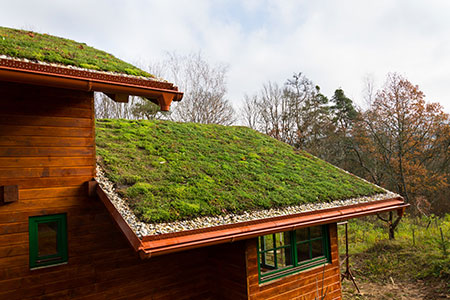Green Roofs: Right for You?
Many American homeowners are in search of ways to make their homes more eco-friendly to promote sustainability and reduce personal energy use. One of the most comfortable and most convenient ways to do that is to install a “living” roof. Green roofs are beautiful, and they’re easier to install than they look. Additionally, green roofs keep homes cooler in the summer and warmer in the winter due to their excellent insulating abilities. Before beginning any roofing project, homeowners should contact a structural engineer to ensure that the existing roof can support the extra weight and stress. The roof may need more joists or bracing to support the greenery, but a reputable contractor can strengthen it to make the living roof safe. Once the roof is deemed reliable for the installation of a green roof, homeowners have to decide on the garden’s design.
The Difference Between an Intensive Green Roof and an Extensive Green Roof
Intensive green roofs are typically found on the top of commercial buildings, whereas extensive green roofs are more suitable for single-family homes. Intensive green roofs have a deeper planting medium than extensive green roofs, and they are known as “rooftop” gardens. The soil depth of intensive green roofs allows for larger, more diverse plants. Extensive green roofs require far less maintenance than intensive roofs. The best placement for an extensive green roof is on a roof that is below another roof so that it can absorb water as it falls. Though the six-inch soil depth of extensive green roofs limits the variety of flora homeowners can grow, plenty of plants are suitable for residential living roofs.
The Best Extensive Green Roof Plants
Many beautiful plants are suitable for living roofs, but others are unable to withstand the extreme conditions. Roofs are exposed to intense heat, cold, snow, wind, and rain, depending on the locale. As a consequence, plants that thrive in “inhospitable” environments such as on cliffs or in deserts do well on rooftops and require very little maintenance.
 Herbs
Herbs
Many herbs grow well in dry, rocky places. Consider planting rosemary, thyme, or oregano, as they don’t require much soil-depth and spread quickly. If a homeowner has safe, regular roof access, a rooftop herb garden can be a fun, unique hobby.
Succulents
Succulents are an excellent choice for living roofs in dry, hot climates. They are drought-resistant and grow well with little soil. Sixty different plant families include succulents or other drought-resistant plants with fleshy parts, and they come in a variety of different colors, sizes, and shapes.
Sedum roofs are popular living roofs due to the natural properties of Sedum, a genus in the Crassulaceae family. The Crassulaceae family includes hundreds of species of succulents, including a two-row stonecrop, one of the most common sedum plants for extensive green roofs.
Two-row stonecrop is a robust, resilient plant that produces star-shaped pink flowers throughout the summer. Sedum plants store water in their leaves, and a roof planted with them can take care of itself. Not only is maintenance incredibly easy, but sedum plants (and other succulents) increase fire-resistance due to their water storage properties.
Another popular sedum variety for green roofs is the widow’s cross. The widow’s cross is a beautiful, sturdy plant with pink and green flowers. It’s drought-resistant and thrives in “inhospitable” conditions, making it perfect for an extensive living roof.
Wildflowers
Wildflowers are an excellent choice for extensive green roofs due to their bright colors and their ability to grow well in rocky, nutrient-poor soils. Be careful, though, as wildflowers require a deeper soil medium than sedum plants or low-lying herbs. Look for a specialized wildflower seed mix made for green roofs.
A popular wildflower for residential or garage green roofs is yarrow. Keep in mind that yarrow requires at least 100mm of a substrate to grow successfully, which can substantially increase the weight and stress on the roof. The white and pink flowers and the sweet smell of yarrow attract bees, but the roof may need watering during dry periods.
Another wildflower well-suited for an extensive green roof is birdsfoot trefoil. The plant’s yellow flowers grow in clusters throughout the summer, and it attracts bees and butterflies due to its abundance of pollen.
Houseleeks
Houseleeks are hardy little evergreens; they can even grow in brick or rock. Also known as sempervivums, houseleeks are well-suited for a rooftop life, and their spiral leaves are aesthetically-pleasing. Forty different species of houseleeks exist; they’re well-suited for colder climates, as they can thrive in freezing conditions.
Grasses
Grasses are an excellent option for a living roof if a large area needs to be covered, due to their ability to spread widely in a short amount of time. However, most grasses need lots of water, so grasses are only a suitable choice for living roofs in wet climates.
Sea thrift is a popular grass-like plant for green roofs. Naturally found in coastal cliffs and dunes, the plant is a perfect choice for homes near a body of water. During the summer, sea thrift sprouts pretty little pink and purple flowers.
The Next Step in Your Green Roof Construction
After choosing the varieties of plants for an extensive rooftop garden, homeowners need to find a suitable substrate. Lightweight options are the best choice so that the roof is under the least amount of strain as possible. Typically, extensive green roofs need multiple layers to ensure safety and to eliminate the possibility of water damage. These layers include waterproof and insulating layers, a root barrier membrane, a drainage layer, and a filter layer. Then, a growing medium such as sedum mats or lightweight inorganic materials can go on top of the roof.
Contact a reputable Portland contractor to help plan the next steps! Happy planting!
